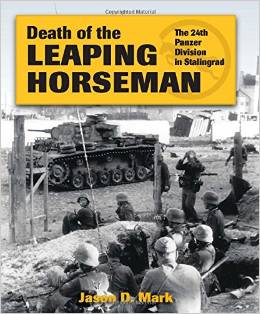The surrender of the German 6th Army following the battle of Stalingrad marked not only the end of the myth of German invincibility but also the demise of many noteworthy units of the German Army. This book is the story of the last six months of the storied 24th Panzer Division whose emblem, the leaping horseman, was representative of its roots as the 1stKavallerie Division. Written at the tactical level with forays into the operational for context, it traces day by day the advance of the 24th across the arid southern steppe of the Soviet Union during the summer of 1942 (Operation Blau) and culminates with the vicious fighting in the fall and early winter in the streets of Stalingrad.
There area number lessons that may be drawn from the German experience in Russia, encapsulated in the successes and lost opportunities of the 24th. Mark’s provision of daily statistics of soldiers and officers killed and wounded as well as panzers available, booty collected and destroyed and the parade states of the Divisional sub-units shed a great deal of light upon the fortunes of the Germans. A very cursory analysis reveals the following:
- The Germans were not able to make good their personnel losses as the campaign progressed and were forced into using rear echelon troops in combat roles. As an example the ration of strength of Panzer-Grenadier Regt 21 was normally 33 officers and 1342 soldiers, by 31 October it stood at 16 officers and 401 soldiers;
- As the fighting intensified within the city of Stalingrad, panzers were more often being employed piecemeal in inappropriate street-fighting environs than in their traditional armoured punch role. This would suggest that the nature of the fighting was becoming more attritional which was completely contrary to the operational doctrine of the Germans;
- The continued success of the Germans despite these handicaps would serve to reinforce the reputation of the depth of leadership well into the NCO levels;
- The inability of the Germans to exploit opportunities and to maintain momentum was due to a great extent, to continued failures in the logistical system to provide spares, sufficient ammunition and, above all, fuel in a timely manner .
Mark has built a reputation for high quality writing and production in his books and this is no exception; copious maps detailing daily movements of the unit, extensive photographs providing visual accounts of written testimonies and a tight writing style that ensures the reader a clear appreciation of the Unit’s efforts and challenges are provided throughout. There are some minor observations that I would make such as an overall photographic map of Stalingrad, scales for the individual maps and photographs of the conditions within the KrasnyOktyabr Steel factory would have assisted to better conceptualize the fighting for the reader.
The author closes his work with a series of appendices that include biographies of all of the officers of the 24th, listing all recipients of the Iron Cross decoration and above, a fascinating account of Panzer IV long-barrel ‘434’s destruction of 11 Russian tanks in close quarter combat (complete with numerous photographs), an in-depth bibliography and a comprehensive listing of the commanders within the panzer division by unit. The appendices are a notable achievement in and of themselves.
The quality of this book as a reference and a history is simply outstanding. Drawing upon interviews with survivors, firsthand written accounts, an in depth knowledge of the fighting and surviving operational records, Mark has created not just an operational/tactical history of the unit but a testament and a eulogy to the officers and soldiers, lost to history, who served, fought and died for each other and the honour of their Division. I highly recommend this book for anyone wishing to better appreciate the nature and conditions of the war in Russia and, more specifically, within Stalingrad.
Reviewed by Chris Buckham for War History Online.
DEATH OF THE LEAPING HORSEMEN
By Jason Mark
Stackpole Books
ISBN: 978-0811714044
Chris Buckham is an active duty major in the RCAF. An avid reader and reviewer, he maintains a blog of his reviews at www.themilitaryreviewer.blogspot.com
